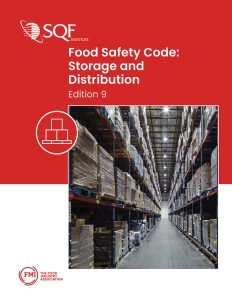A Quick 10-Point Checklist for Managing Risks to Food Safety in a Storage & Distribution Environment
Ensuring the safety and integrity of stored and distributed food products is paramount to every operation. Proper  storage and distribution practices can prevent issues like spoilage, damage, or degradation of food quality.
storage and distribution practices can prevent issues like spoilage, damage, or degradation of food quality.
Take a look at this 10-point checklist to see how you can effectively manage the risks to food safety in a storage and distribution environment. While this is simply a recommended preliminary checklist, it’s a starting point to set you on the path to implementing a comprehensive food safety management system like the SQF program.
Once you are ready to get started with a comprehensive food safety management system, we encourage you to consider the SQF Code for Storage and Distribution, Edition 9.
1. Implement an Effective Storage Plan
- Ensure the plan considers the safe, hygienic storage of ice, food products, packaging, equipment, and chemicals.
- Review and approve all product handling and storage requirements to include temperature, storage, packaging, handling, and transportation requirements.
2. Manage Your Storage & Distribution Practices to Seperate Food Types
- Store raw foods separately from ready-to-eat foods to prevent cross-contamination and allergen cross-contact.
- Use designated storage areas for products containing food allergens, chemicals, and non-food items.
3. Monitor and Record Storage Temperature Controls for All Products
- Ensure refrigeration units are calibrated and function correctly.
- Have procedures in place for handling temperature excursions and documenting corrective actions.
- Have a plan in place for emergencies such as power outages or equipment failure.
4. Incorporate a Robust Pest Prevention Program
- Conduct regular inspections for signs of pests.
- Implement pest prevention measures.
- Seal entry points and ensure all food storage areas are clean and free from cracks or holes to discourage entry of pests.
5. Develop a Food Defense Plan
- Restrict access to storage areas and implement security measures.
- Train employees on recognizing and reporting suspicious activities.
- Reference how to develop a food defense plan in line with SQF requirements.
6. Set Up and Manage a Stock Rotation Program
- Clearly mark expiration dates and ensure visibility for easy monitoring.
- Establish a robust First-In-First-Out (FIFO) system.
- Regularly check and rotate stock to minimize expired products.
7. Develop and Follow a Cleaning and Sanitation Schedule
- Regularly clean and sanitize storage areas, including floors, shelves, and containers.
- Use approved food safe cleaners and sanitizers and train staff on proper cleaning and sanitizing procedures.
8. Provide Employee Training
- Provide comprehensive training on food safety practices, including good personal hygiene practices, temperature control, cleaning and sanitation, and pest control practices.
- Conduct regular refresher courses to keep employees updated on best practices.
- Document all training sessions and ensure records are up to date.
9. Conduct Transportation Checks
- Inspect vehicles used for transporting food prior to loading to ensure they are clean, in good repair, free from odor, and able to maintain appropriate temperatures during transport.
- Apply good practices during loading, transport, and unloading of food products to protect against contamination from biological, chemical, or physical hazards and temperature abuse.
10. Organize Your Documentation and Record Keeping
- Maintain detailed records of all food safety procedures and activities.
- Keep records of temperature logs, cleaning schedules, pest control measures, and employee training.
- Maintain accurate inventory records for traceability and recall purposes.
We encourage you to delve into the meticulous details of the SQF Food Safety Code: Storage and Distribution, Edition 9. Our Storage and Distribution Code can be applied to food sector categories for storage and distribution, particularly in the storage, distribution, and transportation of food products.
Implementing the SQF Code in storage and distribution helps your company manage risks associated with the food supply chain. Clear procedures and standards can mitigate incidents that could harm consumers or your business.
SQF Storage and Distribution Code
Additional Resources:
- The free comprehensive SQF Food Safety Code: Storage and Distribution, Edition 9 Checklist is available to download on the right hand side of our code page and serves as your guiding tool, encompassing critical aspects such as allergen control, temperature management, and pest control to safeguard your products and consumer trust.
- Reference how to implement and maintain an allergen control program as per Module 11 of the SQF Code for Storage and Distribution Edition 9.
- You can team up with an SQF Certification Body or Consultant to navigate SQF Certification and maintain excellence in food safety within your storage and distribution facility.
Recent Blog Posts
SQF Code Edition 10 represents a critical step forward in ensuring rigorous yet practical food safety management across the supply chain.
In an industry where compliance and operational integrity are nonnegotiable, manufacturers and suppliers need more than just certification — they need a globally recognized solution.
Renee McVey is one of the first industry professionals to hold the Safe Quality Food Institute’s new Certified SQF Practitioner credential, which is administered by Exemplar Global.




